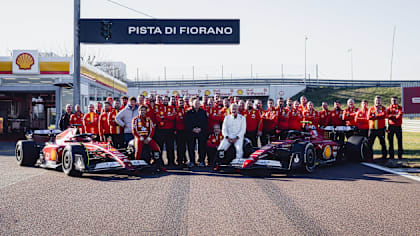Available only to F1 Access subscribers, Formula1.com's live Race Performance Ratings provide unprecedented real-time insight into the action as it unfolds on track during the Grand Prix. For the very first time, the inputs a driver makes can be tracked and viewed by fans, who can compare competitors head-to-head, and at any stage of the race. In the second of five features explaining how the Ratings are calculated, we take a look at Braking - and ask what it can tell us about a dramatic Grand Prix in Malaysia…
What are Race Performance Ratings?
Five key performance parameters are measured: Aggression, Braking, Cornering, Steering and Throttle. Using raw telemetry data, a driver is given a score on a scale of 1-10 for each category, based on how he compares to his competitors. For example, the driver making the most steering inputs at a specific point in the race will be given a score of 10 for the Steering category; the driver making the fewest will be given a 1. The other drivers will be somewhere in between.
The individual scores for each of the five categories - which update every five seconds throughout the race - are then averaged to give an overall Race Performance Rating.
Braking
The braking score is a reflection of how hard a driver is braking into corners. It is calculated by extracting the difference in speed from brake application to release, and dividing it by time spent on the brake. As with the other categories, the raw values for every car are compared and then each driver is ranked on a scale of 1-10. In this instance, at any given time the driver with the highest score is the one who has reduced their speed the quickest/braked the hardest.
Ricciardo and Maldonado leap to the top of the leaderboard

The graph above charts the Braking Ratings for every driver in Malaysia over the course of the Grand Prix. No telemetry was available from Roberto Merhi’s Marussia until the third lap of the race, hence the ‘spike’ seen in all of the other drivers’ scores at the same point.
As you can see in the graph, Red Bull’s Daniel Ricciardo was the hardest driver on the brakes for much of the race, perhaps a reflection of the fact that he was generally embroiled in a battle with another driver or trying to make a pass. For the millions of fans watching on TV around the world, Ricciardo’s hard braking was obvious from the large amount of brake dust that could be seen spewing from his front tyres, particularly under braking for Turn 1.
Around lap 25 the Australian was surpassed in the hard braking stakes by Lotus’s Pastor Maldonado; that was until the Venezuelan was forced into retirement on lap 47 because of a brake problem. Whether or not this was a reflection of his consistent hard braking is unclear.
Into the closing stages of the race and two new names appear at the top of the braking leaderboard - Sauber’s Felipe Nasr and Toro Rosso’s Max Verstappen. Given that these two drivers were both pushing extremely hard in the closing stages - Nasr to catch Romain Grosjean’s Lotus, Verstappen to catch (and eventually pass) team mate Carlos Sainz - it’s perhaps unsurprising that they registered higher values than those not involved in close battles.
Assessing the top three finishers

An interesting observation from the Braking Ratings in Malaysia was that Ferrari’s race winner Sebastian Vettel was never amongst the hardest brakers in the field, but was still able to build and maintain an unassailable lead over the Mercedes duo of Lewis Hamilton and Nico Rosberg.
A lot of this can be attributed to race circumstances (running in clean air versus battling other drivers) but what’s more of a factor here is probably driving style. Some drivers for example are known to favour braking over a longer period of time in order to get back on the throttle earlier, while others favour braking as hard and late as possible. Hamilton is known to be in the latter camp, and the ratings bear this out, particularly at the beginning of the race when the Briton was clearly pushing to establish an early advantage over Vettel. What’s important to note, however, is that both approaches can be equally quick, as Vettel proved.
In contrast to Hamilton, Rosberg has a low Braking Rating in the early stages of the race, but as the Grand Prix unfolds - and his desperation to improve on third position intensifies - the German’s score improves, to the point where he is braking sixth hardest of all by the flag.
Vettel’s score relative to other drivers drops, however, towards the end of the race, a reflection perhaps of him easing towards the finish.
Merhi and the McLarens

Three of the lowest scoring drivers in the Braking Ratings throughout the race were Marussia rookie Roberto Merhi and McLaren’s Fernando Alonso and Jenson Button. Merhi, who as mentioned earlier had telemetry issues until lap 3, seemed very tentative in the braking zones in the early stages of the race, which could perhaps be attributed to the Spaniard’s unfamiliarity with a car that has done very little running to date. By the end of the race, however, Merhi’s score had risen somewhat relative to the rest of the field - an indication perhaps of his growing confidence under braking.
As for the McLaren drivers’ low scores, these were likely a result of the MP4-30 having less straight-line speed than rival cars (Button was fourth slowest through the speed trap in the race, Alonso second slowest), and hence not having to decelerate as much under braking.
Enhance the way you experience Formula 1 racing, and discover a level of detail you won’t find anywhere else - complete with in-depth insights, exclusive content, up-to-the-minute race data, and more - with F1® Access. For a trial membership, or to find out more, click here.




